
The Family Pomacentridae contains over 300 species altogether, some of which are without a doubt the most common fishes in the marine aquarium hobby. Almost all of them are marine, primarily being found in the Indian and Pacific Oceans, but there are a few that may be found in brackish waters, and several species are found in the Caribbean Sea and Atlantic Ocean, as well.
Some of these species are as colorful as a fish can be, and many stay relatively small in size. Some can get along just fine with other fishes and invertebrates, and they’re relatively inexpensive, too. So, they sound wonderful as a whole, but the problem is that only a few species make good additions to most aquariums, rather than all of them. The fact is, despite the general popularity of these fishes, many can be absolutely nasty towards their tankmates. Some get much, much bigger than you might think, and some get quite plain looking or even ugly as they age, too. So, this clan of fishes certainly merits a closer look.
Most of the members of the family are simply called damsels by hobbyists, but some members are called chromises, all of which belong to the genus Chromis. The clownfishes, which hang around in anemones and belong to the genus Amphiprion or Premnas, are also in the same family with the rest of these, too. But, we’ll be sticking with just the “regular” damsels and the chromises here. Clownfishes, despite being in the same family, are unique enough to warrant full-coverage in their own article.
The Good
There are many good things to say about the damsels and chromises. Many are very colorful, and some actually seem to glow under bluish-colored aquarium lighting. Even those that are covered only by black and white stripes and spots can be attractive, as well. Again, many also stay relatively small, even when full grown, which is desirable to most reefkeepers. In fact, quite a few of them won’t get any larger than two or three inches at the most. I’ve provided the maximum reported sizes for several species below (from www.fishbase.org), but keep in mind that these are exactly that – maximums. Most specimens won’t get so large in aquariums, and are often considerably shorter in length even when perfectly healthy and well cared for.
Some species will get along well with other individuals of the same species, and with other species of fishes, too. Many can even be kept in groups of several individuals, which will move around larger tanks in schools. And, almost all of them will leave whatever sorts of non-fish life you have alone, as well.
Additionally, the damsels (but not so much the chromises) are categorically tough. Very hardy indeed, so much so that they have been the number one type of fish used to cycle new aquariums for as long as they’ve been available as best as I can tell. Less than stellar water quality is seldom a problem for them, and most will survive the process of establishing the biological filtration cycle in a tank in stride. No they aren’t bulletproof, but compared to other sorts of fishes, they’re certainly ranked high when it comes to survivability under adverse conditions.
As best as I can tell, they’ll also eat just about anything that you add to a tank that is considered fish food. Flake food, brine shrimp, blood worms, fine bits of fish, clam, and squid meat, sheets of algae, frozen cube foods, etc. Most of them will take it all, and will nibble at some of the unwanted algae that grows on rocks and such, too.
And, as if that’s not enough, they’re cheap. Marine fishes are quite expensive compared to freshwater fishes, but damsels and chromises can still be picked up for just a few dollars at any shop you might visit. Thus, there are lots of reasons to like them.
The Bad
As great as all of that might sound, there are some problems when it comes to many of the damsels. In fact, many of the commonly offered species should be avoided by reef aquarists altogether. Keep in mind that doesn’t mean these same undesirable species aren’t perfectly fine by themselves in a nano reef, or in non-reef aquariums stocked with larger/more aggressive fishes that can take care of themselves, though.
Regardless, some damsels may be very colorful when they’re small, but lose their desirable appearance as they age. Some actually turn completely brown or black when they are mature. Some of them can get much bigger than you might think, too. Several species that are often seen at shops at one to two inches in length can grow and grow until they’re the biggest fish in a tank at times (depending on what else is in the tank, of course).
Still, these are trivial issues compared to the absolutely nasty attitudes many damsels have. Even at small sizes, these fishes are often territorial in nature, and can decide that a large section of a large tank is their territory, or that everything within a small tank is. They’ll defend what they consider to be their own real estate, even against peaceful fishes that are much larger than they are, to the point of pestering them to death. Such damsels will chase and nip at practically any fish that doesn’t have the guts to fight back, and you’d be surprised at how many larger fishes won’t. If this persists, the victim will oftentimes become highly stressed since there’s nowhere to move on to, so that they’ll hide all the time, and may end up sick, and might even die. Large damsels may outright murder smaller fishes, too.
Speaking of, in general you should never try to keep more than one damsel of the same species together unless they have plenty of room and hiding spaces. For that matter, it’s usually a bad idea to mix different species in confined quarters, too. Remember, they can be very territorial, and another damsel, regardless of type will typically be seen as a direct competitor for space. However, some can be kept in schools at times, and the same goes for the chromises. In fact, the popular chromises are best kept in groups and will stick together and swim around in a pack, oftentimes near the top of a tank.
I’ll also add that while they typically won’t bother invertebrates, there are some species that will snack on tiny worms and crustaceans that are quite beneficial in some tanks, especially those that have deep sand beds. Little things like amphipods and copepods will make quick meals for some of them. All things to be considered…
Some Common Species
There are lots of damsels and chromises, but I’ve listed a few common ones below, all of which I’ve had some personal experience with as a hobbyist and when operating an aquarium maintenance business in the past. Just enough to give you a good idea of the variability found between the species, and what may or may not be a good choice for your aquarium. Keep in mind that how common a species is at shops, or how popular they are overall, has little or nothing to do with how suitable they are for a reef aquarium. As you’ll see, many of these are no good for reefers, even in large aquariums.
The sergeant major damsel, Abudefduf vaigiensis
Named for its sergeant-striped body, these damsels and their close cousins can be spotted on just about any dive, anywhere there’s warm water. This is one of the species that looks cute when small, but can grow to a whopping 8 inches and may eat small invertebrates if given the chance.
The blue devil damsel, Chrysiptera cyanea
Awesome blue, but called a devil and a lot of other words that I can’t write here for good reason. They only reach about 3 inches at best, but when it comes to nastiness, these little things can be real terrors. I’ve added these to reef aquariums in the past, and regretted it on every occasion. So, they’re off-limits now, no matter how cheap, tough, and pretty they are.
The yellow tail damsel, Chrysiptera parasema
Mostly blue with a bright yellow tail, these are a little smaller than the blue devils and are far less aggressive. That doesn’t mean they’re necessarily peaceful though, and for a fish with a maximum size of about 2.5 inches, some individuals can be surprisingly obnoxious. Still, these are a far better choice than a blue devil, and most times they don’t cause any troubles, so I generally recommend them.
The azure damsel, Chrysiptera hemicyanea
This species also reaches about 2.5 inches, and looks a lot like a yellow tail with some extra yellow. The tail and the whole belly is bright yellow, with the rest being that same blue color as the two previous species. These are some of my personal favorites, as they tend to be even less aggressive than the yellow tails, although I have had a couple over the years that had poor attitudes. Still, I like them enough to recommend them, too.
The talboti or Talbot’s damsel, Chrysiptera talboti
This one also reaches about 2.5 inches, but doesn’t look at all like the three above. No blue body on this one, but they still have attractive colors, with a black spot on their back. Very pretty, and quite possibly the most peaceful of all the damsels. This species is highly recommended due to its generally peaceful nature, small size, and hardiness, as well.
The three-stripe damsel, Dascyllus aruanus
It is odd to me that with all the colorful marine fishes out there, some that are only black and white are still neat looking enough to bring home. The three-stripe is a good example, as its look is nothing more than 3 broad black and white stripes on a body that doesn’t get more than about 2.5 inches long. Unfortunately, they not only lack color, but they generally lack any tolerance for other fishes, too. Yes, they can be pretty mean.
The four-stripe damsel, Dascyllus melanurus
This one is very similar to the three-stripe damsel in both appearance and attitude. They get just a little bigger, maybe reaching about 3 inches, and they have a black tail rather than a white/clear one, but that’s about it. Mean again.
The domino or three-spot damsel, Dascyllus trimaculatus
These will fool you for sure. They’re seen for sale everywhere and look like cute little dominos when young, but they can also be very aggressive, too. What’s worse is that they typically lose the bright spots, turn a kind of crummy black, and get up to 4 inches long.
The neon-velvet damsel, Neoglyphidodon oxyodon
Same for this one, but worse. When young, this species has cool looking neon blue racing stripes on its black body, but they lose these and turn completely black as they age, and can get up to about 6 inches in length. These are also exceptionally aggressive, even more so than the domino damsel, and I say should never be added to a reef tank.
The Atlantic jewel damsel, Microspathodoon chrysurus
Same, again, except that these will loose all of their bright spots and grow to about 8 inches in length. Mean, mean, mean. Big ones will even take a nip at divers that get too close, which I’ve experienced myself.
The blue-green chromis, Chromis viridis
Finally, we get to something else that I can recommend. The blue-green chromis is a nice color, only gets up to about 3 inches maximum, can be kept in groups, and won’t bother each other or any other sorts of fishes either. Nice. On top of that, they also like to hang around near the top of aquariums, rather than constantly hovering close to and moving about the rockwork. This species is great for larger/deeper tanks, as a small school of them can really add to the overall look, instead of having a lot of less-traveled or even empty space at the top.
The blue chromis, Chromis cyanea
Another schooler, which can be kept singly if you like, these can also be kept in groups and are generally peaceful. This species can reach a maximum of about 6 inches in length though, so they may get a little bigger than what you want. Still, if you don’t mind the size, these are a much better choice than the blue devil damsel if you’re looking for something blue.
To End
So, that’s enough to give you a pretty good idea of what these fishes are like, and as I’m sure you noticed, I only recommended a handful out of these species for reef aquariums. Of course, there are so many species that I can’t cover even a significant percentage of them here, but you’ve got the basic idea now. Thus, it’s up to you to do some homework if you want to try any of these or the others, and I suggest taking a look at Fish Base (www.fishbase.org) before making any purchases. On this site you’ll able to find some specific information about their maximum sizes, habitat, and diets, etc. to help you make informed decisions, and you can often find juvenile and adult photographs for many of them, as well.


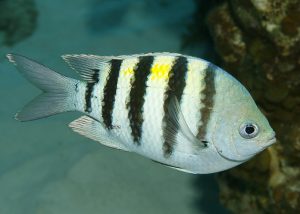
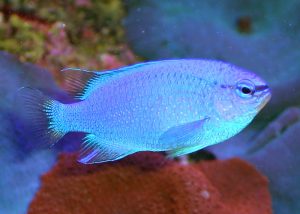

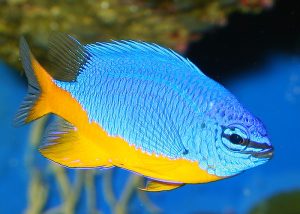
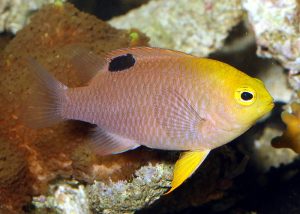
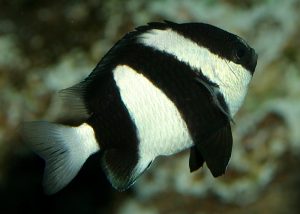
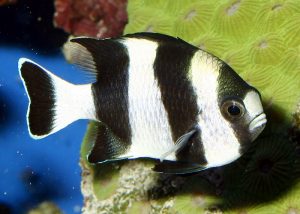
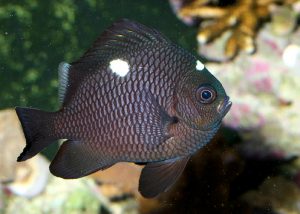
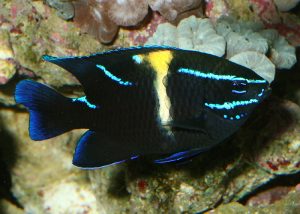
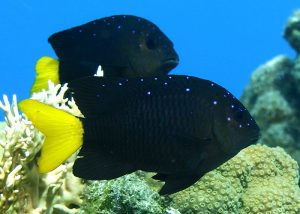

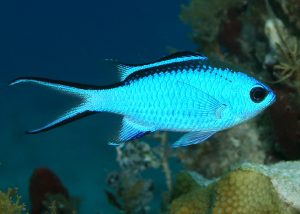

I appreciate the article, very informative.